STOMP Training
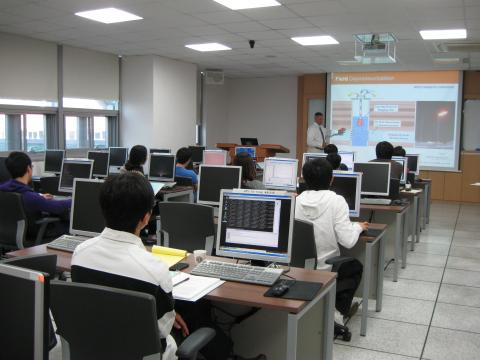
STOMP short courses are taught by code developers and provide new users with an introduction to applying the simulator. The course combines lectures and laboratories, where students are guided through example simulation problems designed to demonstrate the simulator's features.
Lecture topics address documentation, governing equations, constitutive relations, numerical solution schemes, algorithms, applications, parallel computing, and future directions for the simulator.
During the laboratory sessions, students work in pairs or individually on workstation computers, affording hands-on experience with the simulator. Simulation problems vary in complexity and include saturated and unsaturated flow, solute transport, salt-water brine, nonaqueous phase liquid flow, volatile dense nonaqueous phase liquid flow, partition tracers, CO2 sequestration, enhanced oil recovery, and nonisothermal coupled thermal and hydrologic transport.
Example application problems provided here are those presented during an introductory STOMP short course. They are intended to provide the student with a general overview of the code's capabilities and diversity. Each application is described through background text material, images of simulation results, and references to more detailed discussions. Additional exercises with solutions are also provided. The applications have been chosen to demonstrate the simulator's application over a range of scales from laboratory experiments to field deployments of remediation technologies and over a range of hydrologic systems from aqueous flow and transport to nonisothermal natural heat pipes to non-aqueous phase liquid (NAPL) migrations with nonwetting fluid entrapment to frozen soil conditions. The problems are of increasing complexity, ranging from simple one-dimensional saturated flow of a single phase to problems describing flow and transport of several phases.
Courses can be tailored to a particular application area if there is sufficient interest. If you are interested in hosting a short course, please contact Mark White.
Previously Held Short Courses

Rio Tinto, PNNL Campus, Richland, Washington, February 10-17, 2023
This STOMP short course was taught by Dr. Mark White (PNNL) and Dr. Katie Muller (PNNL) and sponsored by Rio Tinto. Attendees were Rio Tinto staff from Bundoora, Australia and PNNL staff. The focus area was geologic storage of CO2 and geochemistry and reactive transport. Active operational modes: STOMP-W, STOMP-GT, STOMP-CO2, and STOMPX-CO2.
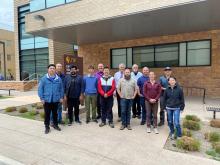
University of Wyoming, Laramie, Wyoming, May 17-19, 2022
This STOMP short course was taught by Dr. Mark White (PNNL) and hosted by the School of Energy Resources, University of Wyoming. Attendees were faculty and students at the University of Wyoming, the Wyoming Geological Survey and PNNL staff. The focus area was geologic storage of CO2 and geochemistry and reactive transport. Active operational modes: STOMP-W, STOMP-GT, STOMP-CO2, and STOMP-EOR.
Carbon Utilization and Storage Partnership (CUSP) of the Western United States, Virtual Course, November 12, 2021-February 4, 2022
This virtual STOMP short course, held over a period of ten weeks, was taught by Dr. Mark White (PNNL), Mark Rockhold (PNNL), and Inci Demirkanli (PNNL) and was sponsored by Carbon Utilization and Storage Partnership (CUSP), a Department of Energy-funded Regional Initiative established to accelerate onshore Carbon Capture, Utilization, and Storage (CCUS) technology deployment in the western region of the United States. Attendees were CUSP partners. The focus area was geologic storage of CO2 and geochemistry and reactive transport. Active operational modes: STOMP-W, STOMP-GT, and STOMP-CO2.
US Environmental Protection Agency, Virtual Course, March 29-April 23, 2021
This virtual STOMP short course, held over a period of four weeks, was taught by Dr. Mark White (PNNL), Signe White (PNNL), Mark Rockhold (PNNL), Inci Demirkanli (PNNL), and Ramesh Sarathi (PNNL) and was hosted by the US EPA. Attendees were staff from US EPA headquarters and regional offices. The focus area was geologic storage of CO2 and geochemistry and reactive transport. Active operational modes: STOMP-W, STOMP-W-R, STOMP-GT, STOMP-CO2, STOMP-CO2-R, and STOMP-EOR.
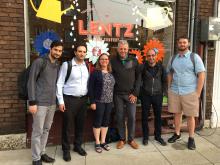
University of Cincinnati, Cincinnati, Ohio, April 22-26, 2019
This STOMP short course was taught by Dr. Mark White (PNNL) and Signe White (PNNL) and hosted by the University of Cincinnati. Attendees were faculty and students at University of Cincinnati. The focus area was geologic storage of CO2 and geochemistry and reactive transport. Active operational modes: STOMP-W, STOMP-W-R, STOMP-GT, STOMP-CO2, STOMP-CO2-R, and STOMP-EOR.

ETH-Zurich, Zurich, Switzerland, September 10-14, 2018
This STOMP short course was taught by Dr. Mark White (PNNL) and Signe White (PNNL) and hosted by ETH-Zurich. Attendees were students at ETH-Zurich. The focus area was geochemistry and reactive transport. Active operational modes: STOMP-W, STOMP-W-R, STOMP-GT, STOMP-CO2, STOMP-CO2-R, and STOMP-EOR.
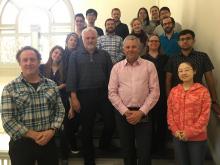
Barnard College, New York, New York, April 21, 2018
This STOMP Short Course was taught by Dr. Mark White (PNNL) and Signe White (PNNL) and hosted by Barnard College. Attendees were project team members of the Cascadia CarbonSAFE Project and included students of Barnard College, Columbia University, University of Michigan, and the University of Illinois. The focus area was geologic sequestration of CO2. Active operational modes: STOMP-CO2 and STOMP-CO2-R.
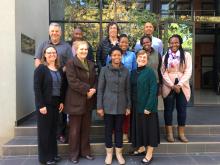
SANEDI, Johannesburg, South Africa, May 29-June 1, 2017
This STOMP short course was taught by Dr. Mark White (PNNL) and Signe White (PNNL) and hosted by South African National Energy Development Institute. Attendees were project team members of the Pilot CO2 Storage Project. The focus area was geologic sequestration of CO2. Active operational modes: STOMP-W, STOMP-CO2, STOMP-CO2-R.

Archer Daniels Midland, Decatur, Illinois, July 21-22, 2015
This STOMP short course was taught by Dr. Mark White (PNNL) and Signe White (PNNL) and hosted by Archer Daniels Midland. Attendees were project team members of the Archer Daniels Midland Illinois Industrial Carbon Capture and Storage program and also included professionals from the Illinois Geological Survey and Schlumberger. The focus area was geologic sequestration of CO2. Active operational modes: STOMP-CO2.
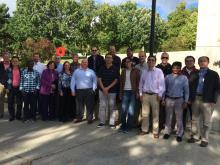
University of Utah, Salt Lake City, UT, September 30-October 1, 2014
This STOMP short course was taught by Dr. Mark White (PNNL) and Signe White (PNNL) and sponsored by the US Department of Energy’s Southwest Partnership on Carbon Sequestration. The course was hosted by Dr. Brian McPherson (University of Utah). Attendees were project team members of the Southwest Partnership on Carbon Sequestration and included professionals, faculty, and graduate students. The focus area was enhanced oil recovery. Active operational modes: STOMP-EOR.
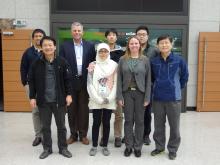
International School for Geoscience Resources of KIGAM (Korea Institute of Geoscience and Mineral Resources), Daejeon, Korea, November 11-15, 2013
This STOMP short course was taught by Dr. Mark White (PNNL) and Signe White (PNNL) and sponsored by the International School for Geoscience Resources of KIGAM. Attendees were principally professionals, faculty, and graduate students. This week-long course was part of a 2-week workshop on Carbon Capture, Utilization and Storage. Therefore, the focus area was geologic sequestration of CO2. Active operational modes: STOMP-W, STOMP-WAE, STOMP-CO2, STOMP-CO2-R, and STOMP-CO2E.
University of Utah, Salt Lake City, UT, May 20-21, 2013
This STOMP short course was taught by Dr. Mark White (PNNL) and Signe White (PNNL) and sponsored by the US Department of Energy’s Southwest Partnership on Carbon Sequestration. The course was hosted by Dr. Brian McPherson (University of Utah). Attendees were project team members for the Southwest Partnership on Carbon Sequestration and included professionals, faculty, and graduate students. The focus area was an introduction to the STOMP simulator for use in carbon sequestration projects. Active operational modes: STOMP-WAE, STOMP-CO2, STOMP-CO2-R, and STOMP-CO2E.
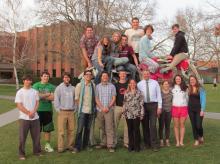
Whitman College, Walla Walla, WA, February 22 and March 1, 2013
This STOMP short course was taught by Dr. Mark White (PNNL) and Signe White (PNNL) and hosted by Whitman College. Attendees were principally students. The focus area was geologic sequestration of CO2. Active operational modes: STOMP-W, STOMP-WAE, STOMP-CO2, and STOMP-CO2E.
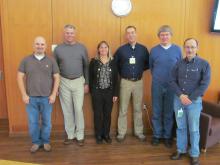
US Environmental Protection Agency Region V, Richland, WA, October 16-18, 2012
This STOMP short course was taught by Dr. Mark White (PNNL) and Signe White (PNNL) and sponsored by the US Environmental Protection Agency. Attendees were principally professionals. The focus area was geologic sequestration of CO2. Active operational modes: STOMP-W, STOMP-WAE, STOMP-CO2, STOMP-CO2-R, and STOMP-CO2E.
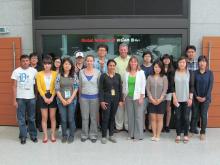
International School for Geoscience Resources of KIGAM (Korea Institute of Geoscience and Mineral Resources), Daejeon, Korea, July 16-20, 2012
This STOMP short course was taught by Dr. Mark White (PNNL) and Signe White (PNNL) and sponsored by the International School for Geoscience Resources of KIGAM. Attendees were principally professionals, faculty, and graduate students. This week-long course was part of a 3-week workshop on CO2 Reduction and Modeling. Therefore, the focus area was geologic sequestration of CO2. Active operational modes: STOMP-W, STOMP-WAE, STOMP-CO2, STOMP-CO2-R, STOMP-CO2E and STOMP-CO2E-GM.
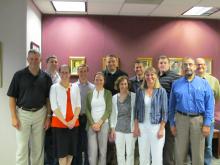
US Environmental Protection Agency Region V, Chicago, IL, July 9-11, 2012
This STOMP short course was taught by Dr. Mark White (PNNL) and Signe White (PNNL) and sponsored by the US Environmental Protection Agency. Attendees were principally professionals. The focus area was geologic sequestration of CO2. Active operational modes: STOMP-W, STOMP-CO2, STOMP-CO2-R, STOMP-CO2E and STOMP-CO2E-GM.
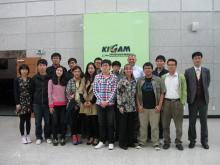
International School for Geoscience Resources of KIGAM (Korea Institute of Geoscience and Mineral Resources), Daejeon, Korea, October 10-14, 2011
This STOMP short course was taught by Dr. Mark White (PNNL) and Signe Wurstner White (PNNL) and sponsored by the International School for Geoscience Resources of KIGAM. Attendees were principally professionals, faculty, and graduate students. The focus areas were geologic sequestration of CO2 and gas hydrate production. Active operational modes: STOMP-W, STOMP-WAE, STOMP-WO, STOMP-WOA, STOMP-CO2, STOMP-CO2E, and STOMP-HYD.
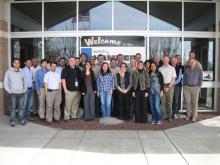
INTERA and CHPRC, Richland, WA, March 10-11, 2011
This STOMP short course was taught by Dr. Mark White (PNNL), Dr. Diana Bacon (PNNL), Dr. Yilin Fang (PNNL), Dr. Vicky Freedman (PNNL), Dr. Mark Rockhold (PNNL), Dr. Andy Ward (PNNL), and Signe Wurstner White (PNNL) and sponsored by INTERA. Attendees were principally professionals working at the Hanford Site. The focus area was environmental applications. Active operational modes: STOMP-W, STOMP-WAE, STOMP-W-R, STOMP-WAE-B, and STOMP-WOA.

University of Utah, Salt Lake City, UT, October 26-27, 2010
This STOMP short course was taught by Dr. Mark White (PNNL), Dr. Diana Bacon (PNNL), and Signe Wurstner White (PNNL) and sponsored by Dr. Brian McPherson (University of Utah). Attendees were principally professionals, faculty, and graduate students. The focus area was geologic sequestration of CO2. Active operational modes: STOMP-W, STOMP-WAE, STOMP-CO2, STOMP-CO2-R, and STOMP-CO2E.
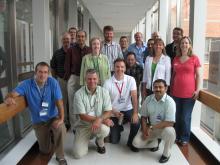
Battelle, Columbus, OH, June 22-23, 2010
This STOMP short course was taught by Dr. Mark White (PNNL), Dr. Diana Bacon (PNNL) and Signe Wurstner White (PNNL) and sponsored by Joel Sminchak (Battelle). Attendees were principally professionals, faculty, and graduate students. The focus area was geologic sequestration of CO2. Active operational modes: STOMP-W, STOMP-WAE, STOMP-CO2, STOMP-CO2-R, and STOMP-CO2E.
Oregon State University, Corvalis, OR, May 24-25, 2007
This STOMP Short Course was taught by Dr. Mark White (PNNL), Dr. Mart Oostrom (PNNL), Dr. Andy Ward (PNNL), and Signe Wurstner White (PNNL), and sponsored by Dr. Dr. Malgorzata Peszynska (Oregon State University). Attendees were principally professionals, faculty, and graduate students. The focus areas were geologic sequestration of CO2, vegetated surface barriers, and gas hydrate production. Active operational modes: STOMP-W, STOMP-WS, STOMP-WAE, STOMP-WO, STOMP-WOA, STOMP-CO2, STOMP-CO2-R, STOMP-W-R, STOMP-WAE-B, STOMP-HYD.
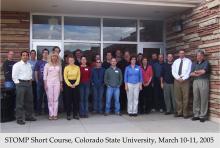
Colorado State University, Fort Collins, CO, March 10-11, 2005 (immediately following the 25th Annual American Geophysical Union Hydrology Days)
This STOMP short course was taught by Dr. Mark White (PNNL) and Dr. Mart Oostrom (PNNL) and sponsored by Dr. Deanna Durnford. Attendees were principally professionals, faculty, and graduate students from the College of Engineering. The principal focus areas were solute transport, organic contaminant migration, and remediation and geologic sequestration of CO2. Active operational modes: STOMP-W, STOMP-WS, STOMP-WAE, STOMP-WO, STOMP-WOA, STOMP-CO2.
Colorado School of Mines, Golden, CO, April 22-23, 2004
This STOMP short course was taught by Dr. Mark White (PNNL) and sponsored by Dr. Tissa Illangasekare (Colorado School of Mines). Attendees were principally graduate students from the Center for Experimental Study of Subsurface Environmental Processes. The focus areas were solute transport and organic contaminant migration and remediation. Active operational modes: STOMP-W, STOMP-WS, STOMP-WAE, STOMP-WO, STOMP-WOA, STOMP-CO2.
University of Alaska Fairbanks, Fairbanks, AK, October 23-24, 2003
This STOMP short course was taught by Dr. Mark White (PNNL) and sponsored by Dr. Tao Zhu (University of Alaska Fairbanks). Attendees were principally faculty and graduate students from the Petroleum Engineering Department. As the graduate students were participating in the collaborative development of STOMP-HYD, the code's solution algorithms and property calculations were emphasized. Active operational modes: STOMP-W, STOMP-WS, STOMP-WAE, STOMP-WO, STOMP-WOA, STOMP-CO2.
Delft University, Delft, Netherlands, June 2003
This STOMP short course was taught by Dr. Mark White (PNNL) and Dr. Mart Oostrom (PNNL) and sponsored by Dr. S. Majid Hassanizadeh (Delft University). Attendees were principally graduate students from across the European Union. The focus areas were solute transport and organic contaminant migration and remediation. Active operational modes: STOMP-W, STOMP-WS, STOMP-WAE, STOMP-WO, STOMP-WOA.
University of Stuttgart—Institute for Water and Environmental System Modeling, Stuttgart, Germany, May 30 - June 1, 2000
This STOMP short course was taught by Dr. Mark White (PNNL) and Dr. Mart Oostrom (PNNL) and sponsored by Dr. Cor Hofstee (University of Stuttgart). Attendees were principally faculty, staff and graduate students from the Institute for Water and Environmental System Modeling. The focus areas were solute transport and organic contaminant migration and remediation. As the faculty and graduate students were participating in the collaborative development of an operational mode of STOMP to investigate the alcohol flooding technology, the extension of STOMP-WO to a ternary liquid system was emphasized. Active operational modes: STOMP-W, STOMP-WS, STOMP-WAE, STOMP-WO, STOMP-WOA.